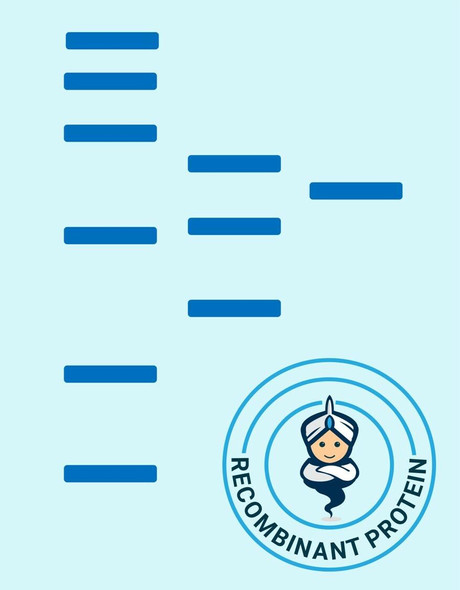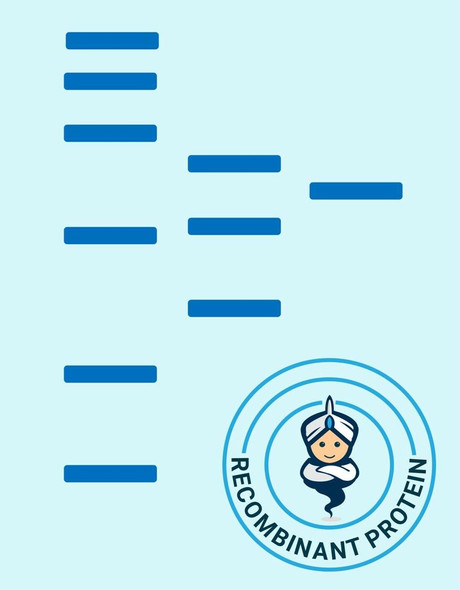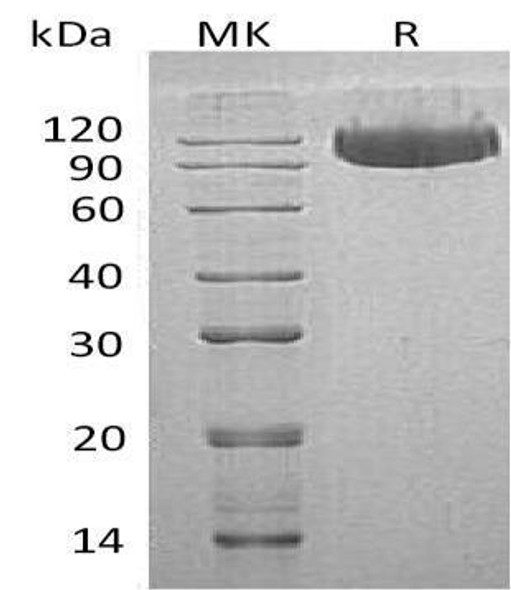Description
| Product Name: | Human SERPING1 Recombinant Protein |
| Product Code: | RPPB4647 |
| Size: | 10µg |
| Species: | Human |
| Target: | SERPING1 |
| Synonyms: | Serpin Family G Member 1, Serpin Peptidase Inhibitor, Clade G (C1 Inhibitor), Member 1, Plasma Protease C1 Inhibitor, C1 Esterase Inhibitor, C1-Inhibiting Factor, Serpin G1, C1NH, C1IN, Serine (Or Cysteine) Proteinase Inhibitor, Clade G (C1 Inhibitor), Member 1, (Angioedema, Hereditary), Serine/Cysteine Proteinase Inhibitor Clade G Member 1, Serpin Peptidase Inhibitor Clade G Member 1, Complement Component 1 Inhibitor, Angioedema, Hereditary, C1 Inh, C1INH, C1Inh, HAE1, HAE2.� |
| Source: | Sf9 Insect cells |
| Physical Appearance: | Sterile Filtered colorless solution. |
| Formulation: | SERPING1 protein solution (1mg/ml) contains 10% glycerol & Phosphate Buffered Saline (pH 7.4). |
| Stability: | Store at 4°C if entire vial will be used within 2-4 weeks. Store, frozen at -20°C for longer periods of time. For long term storage it is recommended to add a carrier protein (0.1% HSA or BSA).Avoid multiple freeze-thaw cycles. |
| Purity: | Greater than 90.0% as determined by SDS-PAGE. |
| Amino Acid Sequence: | ADPEFNPNAT SSSSQDPESL QDRGEGKVAT TVISKMLFVE PILEVSSLPT TNSTTNSATK ITANTTDEPT TQPTTEPTTQ PTIQPTQPTT QLPTDSPTQP TTGSFCPGPV TLCSDLESHS TEAVLGDALV DFSLKLYHAF SAMKKVETNM AFSPFSIASL LTQVLLGAGE NTKTNLESIL SYPKDFTCVH QALKGFTTKG VTSVSQIFHS PDLAIRDTFV NASRTLYSSS PRVLSNNSDA NLELINTWVA KNTNNKISRL LDSLPSDTRL VLLNAIYLSA KWKTTFDPKK TRMEPFHFKN SVIKVPMMNS KKYPVAHFID QTLKAKVGQL QLSHNLSLVI LVPQNLKHRL EDMEQALSPS VFKAIMEKLE MSKFQPTLLT LPRIKVTTSQ DMLSIMEKLE FFDFSYDLNL CGLTEDPDLQVSAMQHQTVL ELTETGVEAA AASAISVART LLVFEVQQPF LFVLWDQQHK FPVFMGRVYD PRAHHHHHH |
Plasma protease C1 inhibitor (SERPING1) is a part of the serpin superfamily of serine protease inhibitors. SERPING1 takes part in regulating activation of both the complement and contact systems. That isdue to the fact that SERPING1 regulates the activation of complement factor C1 in addition to the activity of activated C1 by coupling with the active catalytic site at the light chains of C1r and C1s. Lack of SERPING1 results in hereditary angioedema, which is characterized by recurrent episodes of localized angioedema of the skin, gastrointestinal mucosa or upper respiratory mucosa.
SERPING1 produced in Sf9 Baculovirus cells is a single, glycosylated polypeptide chain containing 489 amino acids (23-500a.a.) and having a molecular mass of 54.2kDa. (Molecular size on SDS-PAGE will appear at approximately 70-100kDa).SERPING1 is expressed with an 11 amino acid His tag at C-Terminus and purified by proprietary chromatographic techniques.
| UniProt Protein Function: | SERPING1: a protein protease inhibitor (C1-inhibitor) that forms a proteolytically inactive stoichiometric complex with the C1r or C1s proteases. May play an important role in regulating complement activation, blood coagulation, fibrinolysis and the generation of kinins. Very efficient inhibitor of FXIIa. Mutations of the SERPING1 gene is associated with adult macular degeneration can also cause hereditary angioedema. Binds to E.coli stcE which allows localization of SERPING1 to cell membranes thus protecting the bacteria against complement-mediated lysis. Belongs to the serpin family. |
| UniProt Protein Details: | Protein type:Secreted, signal peptide; Secreted Chromosomal Location of Human Ortholog: 11q12.1 Cellular Component: extracellular space; extracellular region Molecular Function:serine-type endopeptidase inhibitor activity; protein binding Biological Process: negative regulation of complement activation, lectin pathway; platelet activation; fibrinolysis; platelet degranulation; blood circulation; innate immune response; blood coagulation; complement activation, classical pathway; blood coagulation, intrinsic pathway; aging Disease: Complement Component 4, Partial Deficiency Of; Angioedema, Hereditary, Type I |
| NCBI Summary: | This gene encodes a highly glycosylated plasma protein involved in the regulation of the complement cascade. Its protein inhibits activated C1r and C1s of the first complement component and thus regulates complement activation. Deficiency of this protein is associated with hereditary angioneurotic oedema (HANE). Alternative splicing results in multiple transcript variants encoding the same isoform. [provided by RefSeq, Jul 2008] |
| UniProt Code: | P05155 |
| NCBI GenInfo Identifier: | 124096 |
| NCBI Gene ID: | 710 |
| NCBI Accession: | P05155.2 |
| UniProt Secondary Accession: | P05155,Q16304, Q547W3, Q59EI5, Q7Z455, Q96FE0, Q9UC49 A6NMU0, A8KAI9, B2R6L5, B4E1F0, B4E1H2, |
| UniProt Related Accession: | P05155 |
| Molecular Weight: | |
| NCBI Full Name: | Plasma protease C1 inhibitor |
| NCBI Synonym Full Names: | serpin peptidase inhibitor, clade G (C1 inhibitor), member 1 |
| NCBI Official Symbol: | SERPING1�� |
| NCBI Official Synonym Symbols: | C1IN; C1NH; HAE1; HAE2; C1INH�� |
| NCBI Protein Information: | plasma protease C1 inhibitor; serpin G1; C1-inhibiting factor; C1 esterase inhibitor; complement component 1 inhibitor; serine/cysteine proteinase inhibitor clade G member 1 |
| UniProt Protein Name: | Plasma protease C1 inhibitor |
| UniProt Synonym Protein Names: | C1 esterase inhibitor; C1-inhibiting factor; Serpin G1 |
| Protein Family: | Para-Rep |
| UniProt Gene Name: | SERPING1�� |
| UniProt Entry Name: | IC1_HUMAN |






